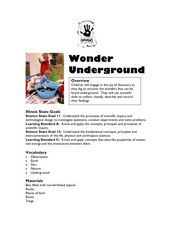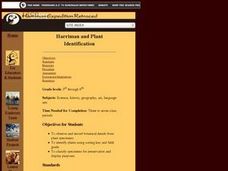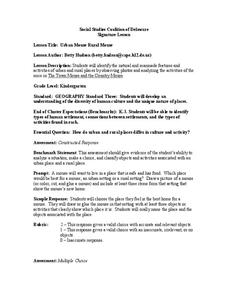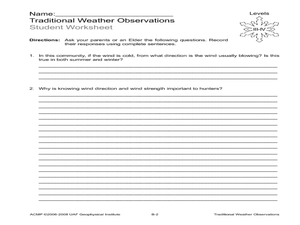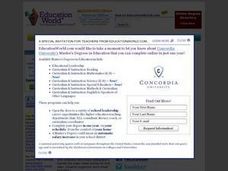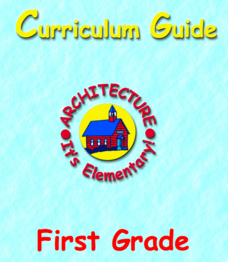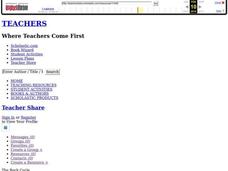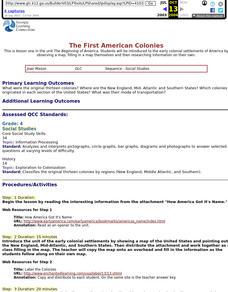Curated OER
Wonder Underground
Students classify and record objects they find "underground." In this observation instructional activity, students dig into bins filled with soil and encounter various objects such as bark, twigs, etc. Students classify their findings.
Curated OER
Harriman and Plant Identification
Students observe and record botanical details from the plant specimens. They identify plants using sorting key and field guide and classify specimens for preservation and display purposes.
Social Studies Coalition of Delaware
Urban Mouse Rural Mouse
Explore rural and urban environments over the course of four days. Each day offers a new look into how both environment compare and contrast. Activities include the observation and analyzation of images, a read aloud and grand discussion...
Curated OER
What Will I Do?
Eighth graders investigate future career choices by looking at classified ads in the newspaper. They consider their lifestyle choices when looking at career options. They prepare a written essay which details how they will prepare for...
Curated OER
Traditional Weather Observations
Students explore traditional methods of weather observation. In this weather lesson, students interview grown-ups regarding wind. Students learn how winds can help forecast weather.
Curated OER
Classifying Information About a Main Idea
Elementary learners explore language arts by completing a text identification activity. They discuss the importance of a main idea in a story or paper and how to present it properly. Then they practice identifying the main idea in sample...
PBS
Classification
Students explore classification skills used in scientific research. They classify a variety of objects in order to compare and contrast. In addition, they analyze previously collected data in order to place items into meaningful groups.
Curated OER
Working on the Slant
Compare and contrast a major news story from various newspapers. How does the perspective change? Are certain things included in some of the stories and left out of others? Have pupils complete a graphic organizer to compare how...
Curated OER
Social Studies Wonders: An Exploration
Help middle schoolers conduct Internet research and develop a working definition for the discipline of social studies. From a list of websites, they develop classification skills and differentiate between primary and secondary sources....
American Institute of Architects
Architecture: It's Elementary!—First Grade
Build an interest and appreciation for architecture in your young learners with this fun 10-lesson art unit. Engaging children in using their five senses, the class first observes the environment around them, paying...
Curated OER
Carbons to Computers - 1
Learners gather and classify information from observation of photographs; to have students differentiate between fact and inference.
Michigan Sea Grant
Fish Identification
Using a dichotomous key, pupils identify characteristics of fish who live in the Great Lakes and explain how these features help them survive. In small groups, class members discover what features scientists consider important and...
Curated OER
Coping with Change
Learners observe changes in their classroom. In this coping with changes lesson, students note the differences in the activities of the day and the changes in the classroom. Learners explain changes in their lives and...
Curated OER
You and the U.S. Constitution
Fourth graders write new rules of their school. In this rules and U.S. Constitution lesson, 4th graders discuss why we celebrate the fourth of July and examine the U.S. Constitution. Students discuss the differences between people now...
Curated OER
The Clouds Tell All
Students examine the different types of clouds and how they form. They are to create their own weather forecast based on their observations of clouds in their area. Questions are asked for comprehension to end the lesson.
Curated OER
The Rock Cycle
Students explore the concept of the rock cycle. In this geology lesson, students identify, classify, and observe three different types of rocks. Students then list and char the characteristics of their rocks.
Curated OER
Uniqueness in All
Students share verbally at least one thing that makes them unique, observe, compare and record their fingerprints, classify which of the basic fingerprints resemble their own and share their findings.
Curated OER
Utilizing Community Resources
Learners gain an understanding of scientific methods and use process skills (such as observing, classifying, and predicting) to solve a problem. They develop an understanding of the need for natural preservation.
Curated OER
Hero Or Zero?
Learners investigate science and technology by reading a children's book. In this reading comprehension lesson, students read the story Archibald Frisby and discuss the ways we use science and technology in everyday life....
Curated OER
Ecosystems: Biotic and Abiotic Factors
Seventh graders examine proper journaling techniques, and record observations about at tree after listening to a read aloud of "Four Worlds: The Dine Story of Creation." They study the difference between living and non-living things, and...
Curated OER
Understanding Content Vocabulary in Employment Ads
Learners use worksheets and classified ads to improve their ability to interpret newspaper employment ads by learning to read and explain commonly used content vocabulary.
Curated OER
Whodunit?
Young scholars observe the geometric patterns on fingerprints. They classify fingerprints into groups and obtain prints from surfaces.
Curated OER
The First American Colonies
Fourth graders are introduced to the early colonial settlements of America by observing a map, filling in a map themselves and then researching information on their own.
Curated OER
Archaeology of the Future
Students view pictures of classmates' homes, make list of different objects in picture, and discuss what they can tell about place from evidence in picture. Students then observe artifact pictures, and read and complete artifact chart.
